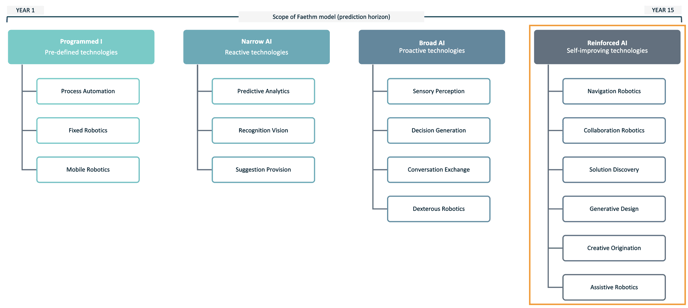Reinforced AI
Reinforced Artificial Intelligence technologies are self-improving agents that can perform unfamiliar tasks.
Skip ahead to:

Reinforced AI can independently learn from experience to perceive and complete new tasks. They perform creative, unfamiliar actions across domains through using reinforced learning.
Navigation Robotics
Robots using reinforcement learning and sensors to navigate autonomously in unstructured environments.
- Self-driving cars
- Autonomous drones
- Planning and exploring agents
For example, Rio Tinto uses driverless trucks provided by Japan’s Komatsu. These trucks move Iron Ore 24-hours a day, navigating using precision GPS and avoiding obstacles using radar and laser sensors. At certain mines, these vehicles work alongside robotic rock drilling rigs and autonomous trains.
Collaborative Robotics
Robots using reinforcement learning and sensors to co-contribute to generating shared meaning.
- Production cobots
- Collaborative robots
For example, industrial automation companies, Omron and Rethink Robotics are producing collaborative robots that work alongside humans to jointly perform tasks such as food and beverage production quality reviews. These robots employ vision systems to monitor and verify aspects of products, synthesising data as they go and providing this to humans.
Solution Discovery
Agents using reinforcement learning and sensors to digest and solve unstructured, complex problems.
- Research software
- Drug discovery
- Prediction and simulation software
For example, pharmaceutical company Pfizer collaborates with IBM Watson’s AI technology to aid its immuno-oncology research. The AI is able to ingest millions of medline abstracts, full-text medical journal articles and patents to develop its understanding. The intent is that Watson’s deep information pool can enable it to make non-obvious connections that could lead to combination medicines for cancer.
Generative Design
Agents using reinforcement learning and sensors to interpret creative data and generate concepts.
- Stories and journalism writing software
- Music, video and Film re-creation
- Artwork creation
For example, the French art collective, Obvious, uses AI and algorithms to create artwork. By training the AI using previous images with common features, the AI is able to learn to distinguish creative patterns and eventually can create its own artwork. In early 2018, Obvious created a portrait ‘Edmond de Belamy, from La Famille de Belamy’ which sold for USD $432,500.
Creative Origination
Agents using reinforcement learning and sensors to invent new and original concepts beyond known data.
- Design simulation software
- New product flavour design software
- Product design programs
For example, AutoDesk’s Project Dreamcatcher software can generate thousands of original design solutions previously not made by humans (across architecture, engineering, construction and manufacturing challenges) to meet specific design goals. It uses mass input data to read and combine possible solutions and alternatives to present designers with expanded options. 3D printers can then produce these designs.
Assistive Robotics
Robots using RL and sensors to physically interact with humans in an emotive manner.
- Movement therapy robot
- Aged care robots
- Robotic prosthetics
For example, Tokyo’s Shin-tomi nursing home uses 20 different models of robots to support caring for its residents. The intent of this, supported by the Japanese government, is to harness robotics expertise to help cater for an increasing elderly population despite a dwindling workforce. The bots serve the purpose of being friendly and helpful; facilitating connection in times of loneliness and a range of individual and group activities